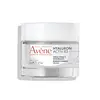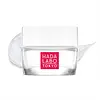What's inside
What's inside
 Key Ingredients
Key Ingredients

 Benefits
Benefits

 Concerns
Concerns

 Ingredients Side-by-side
Ingredients Side-by-side

Water
Skin ConditioningCaprylic/Capric Triglyceride
MaskingGlycerin
HumectantNiacinamide
SmoothingCarthamus Tinctorius Seed Oil
MaskingButyrospermum Parkii Butter
Skin ConditioningGlycol Palmitate
EmulsifyingArachidyl Alcohol
EmollientCetearyl Alcohol
EmollientCellulose
AbsorbentGlyceryl Stearate
EmollientSodium Hyaluronate
HumectantAdenosine
Skin ConditioningArachidyl Glucoside
EmulsifyingBehenyl Alcohol
EmollientCaprylyl Glycol
EmollientCetearyl Glucoside
EmulsifyingCitric Acid
BufferingParfum
MaskingHelianthus Annuus Seed Oil
EmollientSodium Benzoate
MaskingTocopherol
AntioxidantTocopheryl Glucoside
EmollientXanthan Gum
EmulsifyingWater, Caprylic/Capric Triglyceride, Glycerin, Niacinamide, Carthamus Tinctorius Seed Oil, Butyrospermum Parkii Butter, Glycol Palmitate, Arachidyl Alcohol, Cetearyl Alcohol, Cellulose, Glyceryl Stearate, Sodium Hyaluronate, Adenosine, Arachidyl Glucoside, Behenyl Alcohol, Caprylyl Glycol, Cetearyl Glucoside, Citric Acid, Parfum, Helianthus Annuus Seed Oil, Sodium Benzoate, Tocopherol, Tocopheryl Glucoside, Xanthan Gum
Water
Skin ConditioningDipropylene Glycol
HumectantGlycerin
HumectantPentylene Glycol
Skin ConditioningButylene Glycol
HumectantPEG-240/Hdi Copolymer Bis-Decyltetradeceth-20 Ether
StabilisingPPG-17-Buteth-17
Skin ConditioningTriethylhexanoin
MaskingPEG-8
HumectantSorbitol
HumectantPolysorbate 60
EmulsifyingInositol
HumectantPhenoxyethanol
PreservativePropanediol
SolventSorbitan Sesquioleate
EmulsifyingSodium Citrate
BufferingBeheneth-30
CleansingPolyacrylate Crosspolymer-11
Emulsion StabilisingHydrolyzed Hyaluronic Acid
HumectantLactobacillus/Soymilk Ferment Filtrate
Skin ConditioningDisodium EDTA
Citric Acid
BufferingCaprylhydroxamic Acid
Sodium Acetylated Hyaluronate
HumectantPropylene Glycol
HumectantSodium Hyaluronate
HumectantPotassium Laurate
EmulsifyingTocopherol
AntioxidantAlcohol Denat.
AntimicrobialPanax Ginseng Root Extract
EmollientSodium Hyaluronate Crosspolymer
HumectantHydroxyacetophenone
AntioxidantSodium Chloride
MaskingWater, Dipropylene Glycol, Glycerin, Pentylene Glycol, Butylene Glycol, PEG-240/Hdi Copolymer Bis-Decyltetradeceth-20 Ether, PPG-17-Buteth-17, Triethylhexanoin, PEG-8, Sorbitol, Polysorbate 60, Inositol, Phenoxyethanol, Propanediol, Sorbitan Sesquioleate, Sodium Citrate, Beheneth-30, Polyacrylate Crosspolymer-11, Hydrolyzed Hyaluronic Acid, Lactobacillus/Soymilk Ferment Filtrate, Disodium EDTA, Citric Acid, Caprylhydroxamic Acid, Sodium Acetylated Hyaluronate, Propylene Glycol, Sodium Hyaluronate, Potassium Laurate, Tocopherol, Alcohol Denat., Panax Ginseng Root Extract, Sodium Hyaluronate Crosspolymer, Hydroxyacetophenone, Sodium Chloride
 Reviews
Reviews

Ingredients Explained
These ingredients are found in both products.
Ingredients higher up in an ingredient list are typically present in a larger amount.
Citric Acid is an alpha hydroxy acid (AHA) naturally found in citrus fruits like oranges, lemons, and limes.
Like other AHAs, citric acid can exfoliate skin by breaking down the bonds that hold dead skin cells together. This helps reveal smoother and brighter skin underneath.
However, this exfoliating effect only happens at high concentrations (20%) which can be hard to find in cosmetic products.
Due to this, citric acid is usually included in small amounts as a pH adjuster. This helps keep products slightly more acidic and compatible with skin's natural pH.
In skincare formulas, citric acid can:
While it can provide some skin benefits, research shows lactic acid and glycolic acid are generally more effective and less irritating exfoliants.
Most citric acid used in skincare today is made by fermenting sugars (usually from molasses). This synthetic version is identical to the natural citrus form but easier to stabilize and use in formulations.
Read more about some other popular AHA's here:
Learn more about Citric AcidGlycerin is already naturally found in your skin. It helps moisturize and protect your skin.
A study from 2016 found glycerin to be more effective as a humectant than AHAs and hyaluronic acid.
As a humectant, it helps the skin stay hydrated by pulling moisture to your skin. The low molecular weight of glycerin allows it to pull moisture into the deeper layers of your skin.
Hydrated skin improves your skin barrier; Your skin barrier helps protect against irritants and bacteria.
Glycerin has also been found to have antimicrobial and antiviral properties. Due to these properties, glycerin is often used in wound and burn treatments.
In cosmetics, glycerin is usually derived from plants such as soybean or palm. However, it can also be sourced from animals, such as tallow or animal fat.
This ingredient is organic, colorless, odorless, and non-toxic.
Glycerin is the name for this ingredient in American English. British English uses Glycerol/Glycerine.
Learn more about GlycerinSodium Hyaluronate is hyaluronic acid's salt form. It is commonly derived from the sodium salt of hyaluronic acid.
Like hyaluronic acid, it is great at holding water and acts as a humectant. This makes it a great skin hydrating ingredient.
Sodium Hyaluronate is naturally occurring in our bodies and is mostly found in eye fluid and joints.
These are some other common types of Hyaluronic Acid:
Learn more about Sodium HyaluronateTocopherol (also known as Vitamin E) is a common antioxidant used to help protect the skin from free-radicals and strengthen the skin barrier. It's also fat soluble - this means our skin is great at absorbing it.
Vitamin E also helps keep your natural skin lipids healthy. Your lipid skin barrier naturally consists of lipids, ceramides, and fatty acids. Vitamin E offers extra protection for your skin’s lipid barrier, keeping your skin healthy and nourished.
Another benefit is a bit of UV protection. Vitamin E helps reduce the damage caused by UVB rays. (It should not replace your sunscreen). Combining it with Vitamin C can decrease sunburned cells and hyperpigmentation after UV exposure.
You might have noticed Vitamin E + C often paired together. This is because it is great at stabilizing Vitamin C. Using the two together helps increase the effectiveness of both ingredients.
There are often claims that Vitamin E can reduce/prevent scarring, but these claims haven't been confirmed by scientific research.
Learn more about TocopherolWater. It's the most common cosmetic ingredient of all. You'll usually see it at the top of ingredient lists, meaning that it makes up the largest part of the product.
So why is it so popular? Water most often acts as a solvent - this means that it helps dissolve other ingredients into the formulation.
You'll also recognize water as that liquid we all need to stay alive. If you see this, drink a glass of water. Stay hydrated!
Learn more about Water